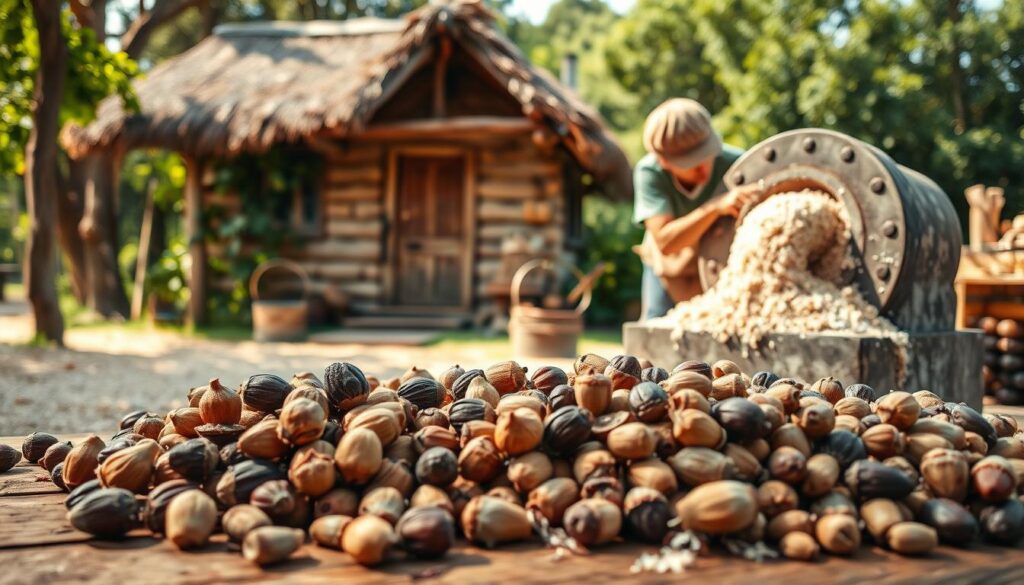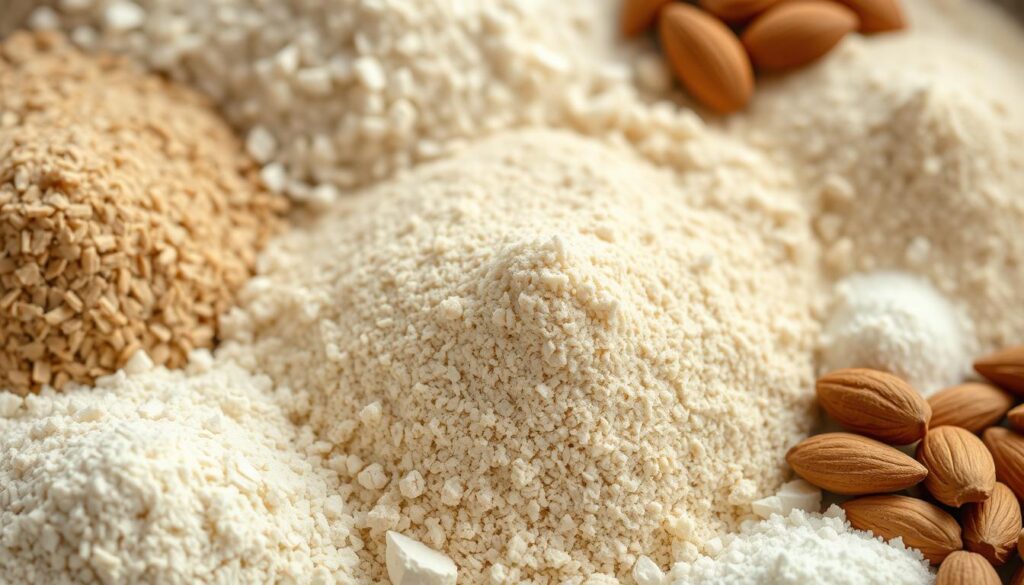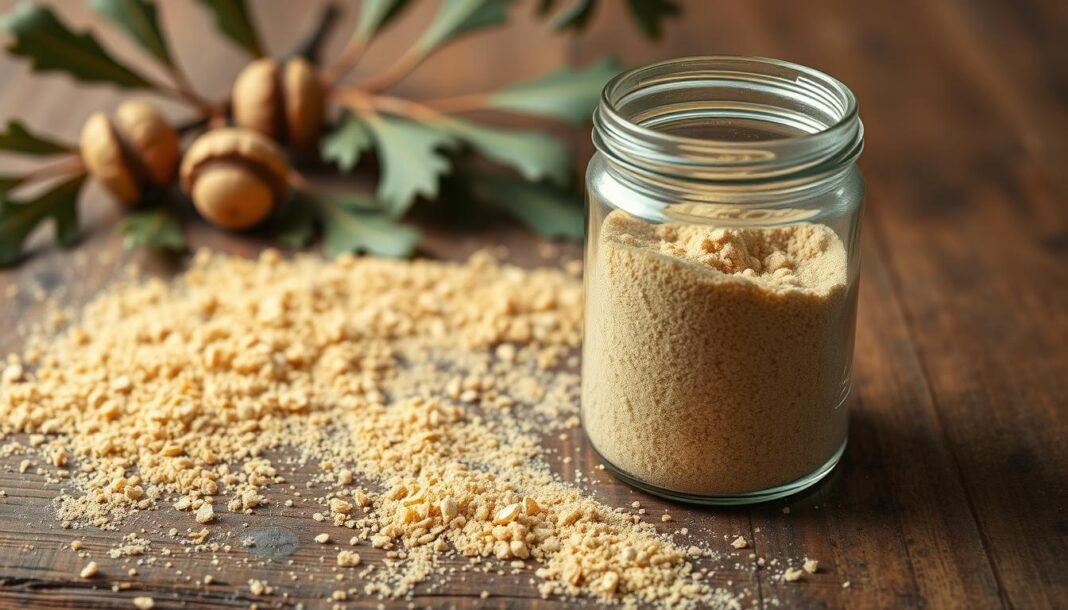Acorn flour is a unique ingredient with a rich history in traditional diets worldwide, offering a distinctive taste and versatile culinary applications. As we explore the flavor profile of this ancient ingredient, we’ll uncover what makes it a favorite among adventurous cooks and those seeking gluten-free alternatives.
With its nutty and slightly sweet flavor, acorn flour presents a fascinating alternative to conventional wheat flour. The processing methods and oak species used to produce acorn flour significantly affect its final flavor, making it a complex ingredient to work with.
At Historical Foods, we empower home cooks with thorough testing and detailed explanations. We examine the culinary versatility of acorn flour and its nutritional benefits, helping you understand if its distinctive taste profile suits your culinary preferences and dietary needs.
Key Takeaways
- Acorn flour has a distinctive nutty and slightly sweet flavor profile.
- The processing methods and oak species affect the final flavor of acorn flour.
- Acorn flour is a versatile ingredient for both sweet and savory dishes.
- It offers nutritional benefits, making it popular among health-conscious food enthusiasts.
- Acorn flour is a gluten-free alternative to conventional wheat flour.
Understanding Acorn Flour: A Traditional Ingredient
Acorn flour is more than just a gluten-free alternative; it’s a product of a labor-intensive process that transforms acorns into a versatile ingredient. We explore the intricacies of acorn flour, from its production to its historical significance.
What Is Acorn Flour?
Acorn flour is produced by grinding acorns, typically after leaching out the bitter tannins they naturally contain. This process creates a fine, gluten-free flour that can be used in various recipes. With about 600 species of oak (genus Quercus) worldwide, the potential for diverse acorn flavors and textures is vast.
Historical Significance and Modern Revival
Historically, acorn flour served as a dietary staple for numerous indigenous cultures, particularly in regions with abundant oak forests like North America, Europe, and parts of Asia. The flour’s significance extends beyond nutrition—it represented a sustainable food source that connected people to their surrounding landscape and seasonal rhythms. In recent years, acorn flour has experienced a revival among foragers, nutritionists, and chefs interested in traditional foods and sustainable eating practices.
- The production of acorn flour begins with harvesting acorns from oak trees, followed by shelling, leaching, drying, and grinding into a fine powder.
- Modern interest in gluten-free alternatives and ancestral diets has contributed to acorn flour’s resurgence in contemporary kitchens.

The Unique Flavor Profile of Acorn Flour
The flavor profile of acorn flour is characterized by its earthy undertones, nutty richness, and subtle sweetness. This complex combination sets it apart from more conventional flours, making it a valuable addition to various recipes.

Nutty Undertones
Acorn flour’s nutty essence is warm and rich, reminiscent of roasted hazelnuts or chestnuts. This characteristic is particularly pronounced when the flour is lightly toasted, enhancing its natural flavor.
Earthy Characteristics
The earthy undertone is a defining feature of acorn flour, lending a grounded, natural quality to dishes. This earthiness connects culinary creations to the forest floor and wild ingredients, adding depth to recipes.
Mild Sweetness
Unlike conventional wheat flour, acorn flour contains a mild natural sweetness, especially when sourced from white oak acorns, which are lower in tannins. This sweetness varies depending on the oak species used.
Rich Depth and Complexity
The interplay between acorn flour’s nutty, earthy, and sweet notes creates a rich depth and complexity. This multidimensional flavor profile makes acorn flour particularly valuable in recipes where depth and character are desired, enhancing both sweet and savory applications.
What Does Acorn Flour Taste Like Compared to Other Flours?
The unique flavor profile of acorn flour sets it apart, but a comparison with wheat and other nut flours reveals its true character. Acorn flour offers a rich and complex taste experience that differs significantly from both wheat flour and other nut flours.
Acorn Flour vs. Wheat Flour
When compared to conventional wheat flour, acorn flour presents a more complex flavor profile with pronounced nutty and earthy characteristics. Unlike wheat flour, which serves as a neutral base in baking, acorn flour actively contributes flavor to breads, pastries, and other baked goods. The structural differences are also notable; wheat flour contains gluten that provides elasticity and structure, while acorn flour is naturally gluten-free and behaves differently in baking applications.
| Characteristics | Acorn Flour | Wheat Flour |
|---|---|---|
| Flavor Profile | Nutty, Earthy, Complex | Neutral |
| Gluten Content | Gluten-free | Contains Gluten |
| Baking Behavior | Different, requires adjustments | Standard, traditional baking |
Comparison with Other Nut Flours
Among nut flours, acorn flour stands out for its balanced earthiness. While it shares some earthy and nutty notes with almond, chestnut, and hazelnut flours, it brings a depth of flavor that sets it apart. Acorn flour is more robust and earthy, with less sweetness than almond flour. Both acorn and chestnut flours are earthy, but acorn flour can be more intense, especially from red oak varieties. Hazelnut flour emphasizes nuttiness, while acorn flour adds more versatility in savory dishes.

We find that acorn flour’s versatility allows it to work well in both sweet applications, like almond flour, and savory dishes, similar to chestnut flour, making it uniquely adaptable. When substituting acorn flour for wheat flour in recipes, the flavor impact must be considered—it will impart its characteristic taste to the final product. Many bakers find that blending acorn flour with wheat flour or other nut flours creates an optimal balance of flavor contribution and structural integrity in baking applications.
Factors Affecting Acorn Flour Taste
Acorn flour’s taste can vary significantly based on several key elements, from the oak species to the processing techniques used. Understanding these factors is crucial for achieving the desired flavor in culinary applications.
Oak Species Variations
The species of oak tree from which acorns are harvested plays a significant role in determining the flour’s taste. For instance, white oak acorns, such as those from Quercus alba, have lower tannin content, resulting in a sweeter and more delicate flour. In contrast, red oak acorns tend to have higher tannin levels, giving the flour a more bitter and robust flavor.
Processing Methods and Tannin Levels
The processing method, particularly the leaching process, significantly affects the final taste of acorn flour. Cold leaching preserves more starches and natural sweetness, while hot leaching reduces starch content and can result in a less bitter but potentially less complex flavor.
Drying Techniques
Drying techniques also influence the flavor and texture of acorn flour. Slow, low-temperature drying helps maintain nuanced flavor compounds, whereas high-heat methods can compromise the flour’s quality.
Freshness and Storage
Freshness is crucial to acorn flour’s optimal taste. Proper storage in airtight containers, preferably in cool, dark conditions or frozen, helps preserve the complex flavor profile.
| Factor | Impact on Flavor | Best Practice |
|---|---|---|
| Oak Species | Variability in tannin content affects bitterness and sweetness | Choose white oak for sweeter flour |
| Processing Method | Leaching process influences starch content and bitterness | Use cold leaching for more complex flavor |
| Drying Technique | Drying method affects flavor compounds and texture | Opt for slow, low-temperature drying |
| Freshness and Storage | Proper storage preserves flavor profile | Store in airtight containers in cool, dark conditions |
How to Make Acorn Flour at Home
With a few simple steps, you can transform raw acorns into a fine, nutritious flour perfect for baking and cooking. The process involves several key stages: harvesting and sorting acorns, shelling and leaching, and finally, drying and grinding.
Harvesting and Sorting Acorns
The journey to making acorn flour begins with harvesting mature acorns that are free from mold or weevil damage. Ideally, collect them when they’ve fallen naturally from oak trees. Sorting is crucial; discard any acorns that float in water as they may be damaged or empty.
Shelling and Leaching Process
Remove the hard outer shells using a nutcracker or pliers, and if possible, the thin inner skin to reduce tannin content. Leaching is critical; soak the shelled acorns in water, changing it regularly until the bitterness subsides. Cold water leaching, which takes around 5-10 days, preserves more starches and results in a higher quality flour.
Drying and Grinding Methods
After leaching, dry the acorns thoroughly using a food dehydrator, a low-temperature oven, or sun drying. Once dry, grind them into a fine powder using a grain mill, high-powered blender, or food processor.
| Method | Time | Outcome |
|---|---|---|
| Cold Water Leaching | 5-10 days | Higher quality flour, better binding properties |
| Hot Water Leaching | Fewer days | May lose some natural starches |
| Drying Methods | Varies | Moisture-free acorns, essential for grinding |
By following these steps and being patient, you can produce high-quality acorn flour at home, ready for use in various culinary applications.
Culinary Applications for Acorn Flour
With its unique flavor profile, acorn flour opens up new possibilities for culinary creativity in both sweet and savory recipes. Its versatility allows it to shine in multiple dishes, making it a valuable addition to any kitchen.
Baking with Acorn Flour
Acorn flour is particularly well-suited for baking applications, where its nutty, earthy flavor can enhance traditional recipes like pancakes, muffins, cookies, and quick breads. When baking with acorn flour, it’s generally recommended to blend it with wheat flour or other gluten-containing flours at a ratio of 1:3 or 1:2 to maintain proper structure.
Savory Dishes and Thickening Agents
In savory applications, acorn flour makes an excellent thickening agent for soups, stews, and sauces, imparting a subtle earthy richness. It’s also used in making roux, coating meats, and as a flour additive in breads and pasta.
Paleo and Gluten-Free Applications
Acorn flour is particularly valued in paleo and gluten-free diets for its nutritional profile and prehistoric usage. It’s incorporated into grain-free pancakes, tortillas, and flatbreads, offering a complex flavor profile that’s hard to achieve with typical gluten-free ingredients.
Nutritional Benefits of Acorn Flour
Rich in essential nutrients, acorn flour is a valuable addition to a healthy diet. We explore its nutritional benefits, highlighting its fiber, mineral content, and antioxidant properties.
Fiber and Mineral Content
Acorn flour is particularly noteworthy for its high fiber content, providing both soluble and insoluble fiber that supports digestive health and promotes satiety. It is also rich in minerals such as potassium, magnesium, calcium, and phosphorus, which are often lacking in conventional grain-based flours. The mineral content in acorn flour supports overall health, making it a nutritious alternative to traditional flours.
| Mineral | Amount per 100g | Health Benefit |
|---|---|---|
| Potassium | 1200 mg | Supports heart health |
| Magnesium | 150 mg | Aids in muscle function |
| Calcium | 80 mg | Essential for bone health |
Antioxidant Properties
The antioxidant properties of acorn flour come from compounds like tannins, gallic acid, and quercetin, which help combat oxidative stress in the body. Research suggests that the polyphenols in acorn flour may have anti-inflammatory properties, potentially benefiting those with inflammatory conditions. With its relatively low glycemic index, acorn flour provides sustained energy, making it suitable for blood sugar management.
Tips for Enhancing Acorn Flour’s Flavor
We can bring out the best in acorn flour by using it in innovative ways and pairing it with the right flavors. Acorn flour’s unique taste can be further enhanced to create a variety of delicious dishes, from baked goods to savory meals.
Complementary Ingredients and Spices
To enhance the flavor of acorn flour, we can use complementary ingredients and spices. Warming spices like cinnamon, nutmeg, and allspice pair exceptionally well with acorn flour in sweet recipes, bringing out its natural nuttiness. For savory applications, herbs like rosemary, thyme, and sage create harmonious flavor combinations, particularly in breads and pancakes.
- Toast acorn flour before use to intensify its nutty flavor profile.
- Use sweeteners like maple syrup, honey, and brown sugar to complement its earthy characteristics.
Blending with Other Flours
Blending acorn flour with other flours can achieve the desired taste and texture. For instance, combining it with chestnut flour enhances sweetness, while hazelnut flour adds pronounced nuttiness. The optimal ratio when blending acorn flour with wheat flour is typically between 1:3 to 1:2, allowing the acorn flavor to shine through while maintaining a familiar texture.
Conclusion: Embracing the Unique Taste of Acorn Flour
As we conclude our exploration of acorn flour, it’s clear that this ancient ingredient offers a wealth of culinary possibilities. Acorn flour’s unique flavor profile, combining nutty, earthy, and subtly sweet notes, can elevate both sweet and savory recipes. By understanding the factors that influence its taste and experimenting with different applications, cooks can unlock its full potential. We encourage you to try acorn flour in your next batch of pancakes or bread, and discover the rich flavors it brings to your table.


